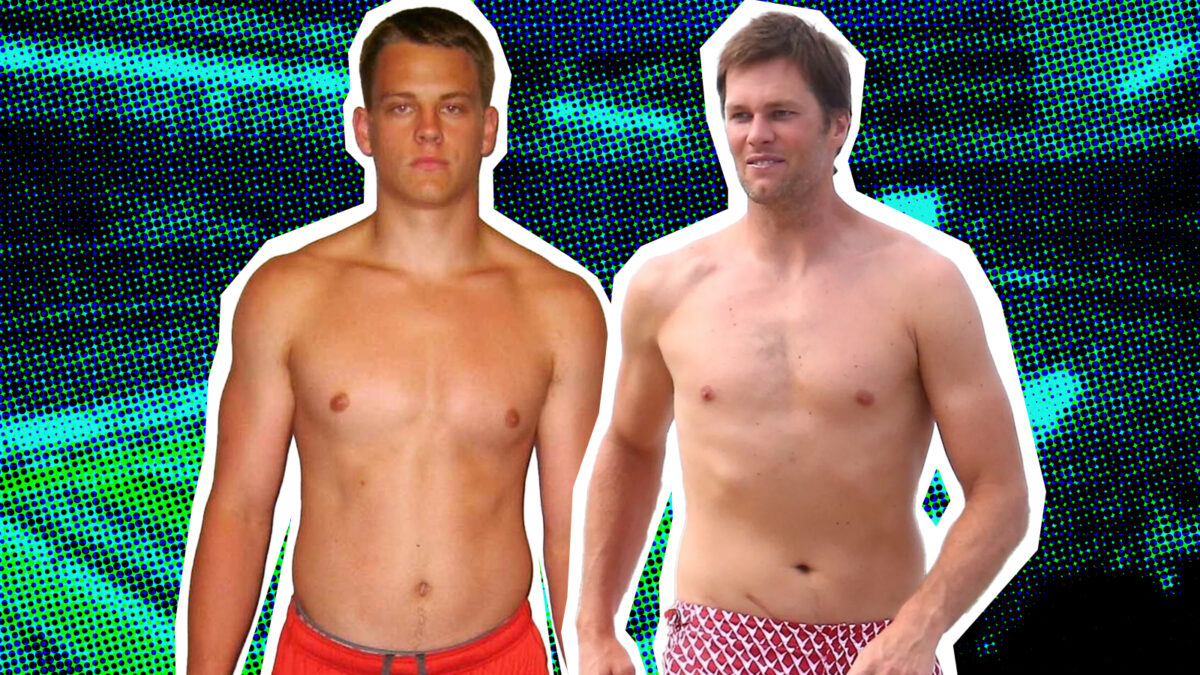Professional athletes need to maintain a heightened level of fitness, so much so that we expect athletes competing in any sport to be certifiably ripped. But what about NFL quarterbacks? Many don’t have the chiselled six-packs you might expect. But there’s a perfectly justified reason.
We’ve already discussed how getting ripped is overrated anyway, using Tom Brady as an example. When we published that article, we used an image of Tom looking not unfit by any means, but not exactly what you would imagine a world-class athlete to look like. Today, it’s hard to find an image of Tom without a shirt on, but this family portrait from 2021 shows he certainly has greater muscle definition than he did in 2018.
But for Tom Brady and his NFL quarterback peers, having a six-pack and being lean could almost be a detriment to their performance. Tom’s physique and that of other current quarterbacks in the NFL, such as Joe Burrow, aren’t perhaps as physically impressive as wide-receiver DK Metcalf, for example, who is an absolute unit. Chicago Bears’ QB Justin Fields may also be an exception to the rule.
The role of the quarterback, in case you were blissfully unaware, is to lead the offence. This means they call the order of play, will receive the ball from the centre and then throw the football long down the field to a receiver.
In short, they don’t move around the pitch as much as some of their team members, but they do need to be able to withstand tackles from the opposing team. It’s for these reasons that their physical appearance is as it is. Plus, using Tom Brady as an example again, with his legendary status and crazy-high paycheck, we don’t think he would actually care if he has a six-pack or not. He still performs on the pitch, when it matters (not to mention it’s a bit sad that some people are still body shaming him, in this supposedly enlightened era we live in).
RELATED: American Man’s ‘Beast Mode’ Bench Press Highlights Difference Between Strength & Size
As Ben Lucas, former NRL hotshot and founder of Flow Athletic tells DMARGE, “Quarterbacks are the MVP of any team. They need to inspire the team, call the huddles, make the calls and ensure that their passes are accurate and get to where they need to be.”
“QBs on average are around 6’3″ which allows them to see about the shorter players and make passes that shorter players may not otherwise be able to make. They are also often big guys, with some articles saying that they are 25 pounds heavier than a defensive back, but 90 pounds lighter than a defensive linesman.”
In the case of Tom Brady, he stands at an impressive 6 ft 4 in and weighs around 102kg. The average weight of a defensive lineman in the NFL is 142kg, and for a defensive back, around 90kgs.
Speaking of the training routine of an NFL quarterback, Ben tells DMARGE, “The training routine would be well rounded with strength, cardio and training that will improve their throwing ability into the mix. They would do a lot of single arm work, rotational work such as lunges with a weighted rotational twist, and exercises to reduce the chance of arm and shoulder injuries, such as T raises.”
Touching on the training exercises more specific to a quarterback, Ben continues, “Throwing would be one of their most important things to focus on, as would cardio and endurance. Lots of their work would be single arm exercises to ensure both arms are being trained equally and lateral movement.”
In short, NFL quarterbacks need to be strong, not just to have serious throwing power, but to give them the stamina to last around 3 hours on the pitch. To help illustrate why a ripped physique doesn’t necessarily mean someone is going to be strong, Ben elaborates,
“Having a ripped physique often comes down to genetics and diet. The thing with gridiron players is that they get hit and pushed a lot, so they need to be big and strong.”
“Therefore, their diets would probably not be as lean (depending on their position) as a runner, swimmer or attacking player in rugby league. It is safer for an NFL player to be a little bulkier, given how hard they are allowed to run into each other in a game.”
Read Next
